April 04, 2019
In honor of Women’s History Month in March, Sigma Xi asked female members about the challenges they see for women in science, technology, engineering, and math (STEM) as well as possible solutions for those issues.
Andrea Armani
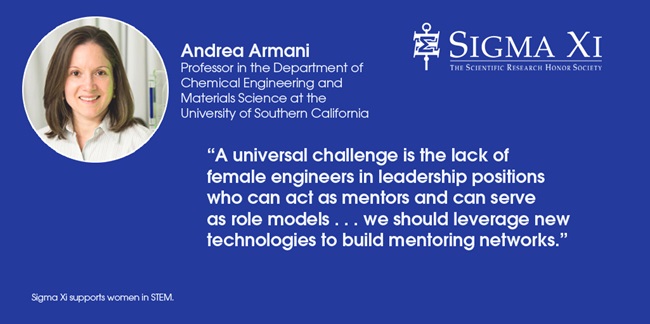
Current position
Professor in the Department of Chemical Engineering and Materials Science at the University of Southern California (UCS)
What challenges do you see for women working in, or studying, science, technology, engineering, or math?
Depending on the career stage, the challenges are very different. However, in many ways, a universal challenge is the lack of female engineers in leadership positions who can act as mentors and can serve as role models. Additionally, as a result of this imbalance, the few female scientists in leadership positions carry a disproportionate burden of outreach as compared to their male counterparts.
What do you think could be done to help overcome those challenges?
I encourage all of my students to identify researchers who are good mentors and to proactively contact them for advice. However, as a scientific community, we need to do better. We should leverage new technologies to build mentoring networks and more effectively utilize existing mentoring resources. We also need to recognize that demonstrating scientific leadership goes beyond scientific discovery. When evaluating scientific leadership for inclusion in the National Academies of Science, Engineering, and Medicine, a researcher’s contributions both in and out of the lab should be considered. In many ways, there are many possible opportunities for positive change, if the scientific community can work together.
Beth A. Cunningham
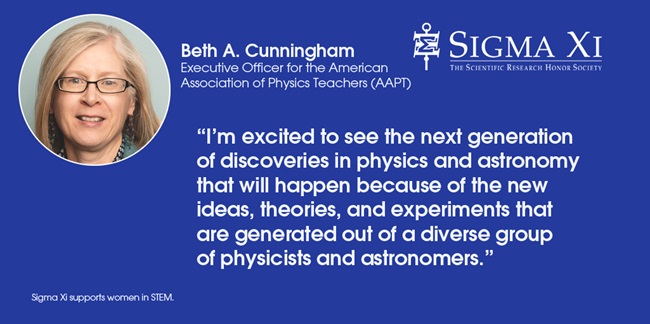
Current position
Executive officer for the American Association of Physics Teachers (AAPT)
What challenges do you see for women working in, or studying, science, technology, engineering, or math?
Women, particularly women from underrepresented groups, face a number of challenges including implicit bias, stereotype threat, microaggressions, and, in some cases, explicit bias. These types of experiences can make women feel excluded and discourage them from considering or continuing in STEM careers. Physics may be considered an objective science but yet physics has a culture that has encouraged participation by only the “best and brightest” which has often meant white males. The challenge for many areas of STEM is how to change the culture to be more inclusive.
What do you think could be done to help overcome those challenges?
There are a number of ways to overcome these challenges including: finding spaces where women can talk about their challenges and develop solutions together; training allies, especially male allies, to support women when they experience biases and harassment; providing opportunities for all STEM professionals to learn more about the challenges women face in the workplace and the ways that women can be supported; providing mentors and sponsors to help women progress in their careers; and developing women and family-friendly policies in academia and the workplace. Professional societies have a key role in helping the community make changes since our members look to us for leadership. I’m currently working on a project that will challenge physics and astronomy departments in higher education in the U.S. to reflect on their policies and practices and develop action plans to make the cultural changes that are needed to retain the full range of talent. I’m excited to see the next generation of discoveries in physics and astronomy that will happen because of the new ideas, theories, and experiments that are generated out of a diverse group of physicists and astronomers.
Marcetta Darensbourg
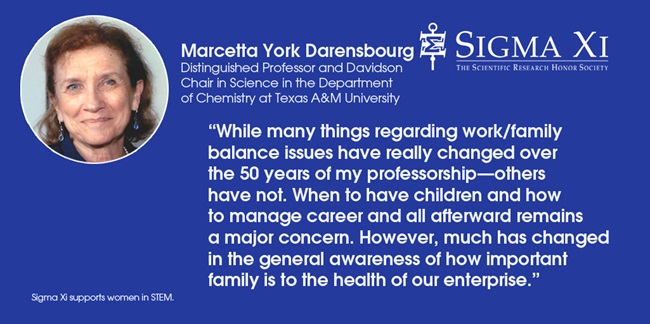
Current position
Distinguished professor and Davidson Chair in Science, Department of Chemistry, Texas A&M University; Fellow of the American Association for the Advancement of Science
What challenges do you see for women working in science, technology, engineering, or math?
While many things regarding work/family balance issues have really changed over the 50 years of my professorship—others have not. When to have children and how to manage career and all afterward remains a major concern. However, much has changed in the general awareness of how important family is to the health of our enterprise; how important it is to have a “life” outside of the lab or lecture hall; how important it is to support personal decisions; how important it is to have a support network. I owe so much to the women and men who fought for this awareness. Personal challenges persist, including getting recognition for ones ideas, not worrying if we appear to be overly aggressive when trying to speak as loudly as our male counterparts.
What do you think could be done to help overcome those challenges?
We are on the right track. Increasing numbers of women in the STEM jobs makes the field more attractive both within and for recruiting. Support groups and programs in universities and in national conferences that address challenges are frequently also attended by young men. Our challenges are not unique. We must persist and simply carry on.
Jordan B. Harrod
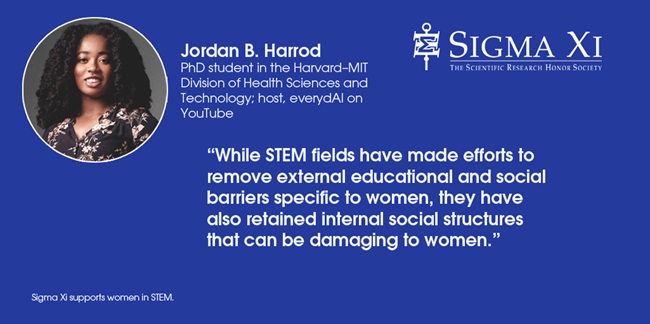
Current position
PhD student in the Harvard–MIT Division of Health Sciences and Technology; host of everydAI on YouTube
What challenges do you see for women working in, or studying, science, technology, engineering, or math?
The field of biomedical engineering is actually fairly diverse in terms of gender (compared to other fields), but there are certainly still hurdles that women working in STEM fields face today. One of the bigger ones that I’ve noticed is that while STEM fields have made efforts to remove external educational and social barriers specific to women, they have also retained internal social structures that can be damaging to women, specifically as it pertains to the #MeTooSTEM movement. This is not to say that science should not be judged on merit, but to say that scientists who have sexually harassed their female peers and students should not be praised for their scientific work without equally acknowledging and addressing their wrongdoings. In addition, these social structures encourage superiors to suppress the voices of researchers, often women, who are trying to reform these systems by bringing those wrongdoings to light.
What do you think could be done to help overcome those challenges?
I think that continuing to highlight these wrongdoings will help the STEM community make strides towards overcomes these challenges, but I also think that the STEM community will have to consciously shift internal social structures to acknowledge that scientists are not exclusively defined by their science, but also by their impact on their communities.
Jarita C. Holbrook
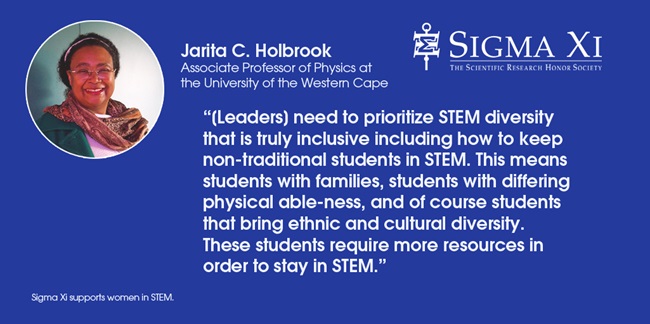
Current position
Associate professor of physics at the University of the Western Cape (UWC) in South Africa; filmmaker; astrophysicist; cultural astronomer
What challenges do you see for women working in, or studying, science, technology, engineering, or math?
The challenge has to do with trying to change STEM culture to a culture that can recognize talent even when it doesn’t reflect the dominant culture. Many scientists think that they can assess a person’s intellectual ability in as short a time as five minutes of conversation! They then move forward with that limited judgment as if it is both valid and as if the judged person cannot learn, grow, and change. Also, I feel that scientists take advantage of the good will of young women who want to be helpful but dangerously assume that everyone is working to aid their success. The projects that will lead to publications, travel to conferences, and career advancement are patronizingly withheld from young women under the rubric of “they aren’t ready, yet.” Young women trust their advisor’s judgment until they don’t. Then they go through a cycle of disbelief, hurt, anger, evolving to rage and wanting to exit their discipline, because it isn’t just their advisor that has betrayed them, the other faculty are complicit. Being a good advisor means hitting that sweet spot of intellectually pushing your students without setting them up to fail, but always keeping them abreast of where you want to see them in the future: as colleagues.
What do you think could be done to help overcome those challenges?
Many ways to change the culture have been proposed and some of these have worked in many disciplines but not in all of STEM. Leadership is important, the leaders set the priorities and they need to prioritize STEM diversity that is truly inclusive including how to keep non-traditional students in STEM. This means students with families, students with differing physical able-ness, and of course students that bring ethnic and cultural diversity. These students require more resources in order to stay in STEM, and we need to make sure those resources are available.
As an aside, in South Africa, we are not just focused on transforming STEM, but are in conversations about identifying structural change to decolonize academia.
Ellen Ochoa
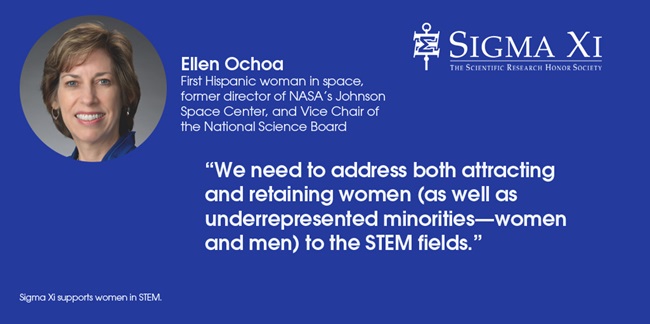
Current position
Vice Chair of the National Science Board. She was an astronaut, the first Hispanic woman in space, and the 11th director of NASA’s Johnson Space Center (JSC).
What challenges do you see for women working in, or studying, science, technology, engineering, or math?
While the representation in these fields is much better than when I started out, women in most STEM fields still don’t see a lot of other women, and that’s especially the case in computer science, electrical engineering, and physics. Often, women don’t have the same opportunities as men, such as participating in training and development programs, leading teams, or being prepared for and selected for promotions. However, many organizations are now much more aware of unconscious bias and have changed some of their processes to help address it.
What do you think could be done to help overcome those challenges?
We need to address both attracting and retaining women (as well as underrepresented minorities—women and men) to the STEM fields. Some of the actions that organizations and individuals have undertaken, which I have personal knowledge of particularly in my role as director of JSC, include:
-
Getting the stories of women in the field more broadly disseminated (see, for example, the Women@NASA website, including through social media
-
Targeting materials and programs for middle school girls, before they start to make choices in high school that limit their options
-
Providing both mentors and sponsors in college, graduate school, and early in the professional career
-
Ensuring that women are fairly represented in training and development programs
-
Utilizing (diverse) panels for promotions and awards rather than a single individual
-
Advertising both formal and informal opportunities in the work environment (e.g. leading or participating on an ad hoc team) so that women can express their interest, rather than having a supervisor just select someone, which is often the same person over and over
-
Supporting Employees Resource Groups, which provide informal leadership opportunities, help an organization attract and retain women and other members of underrepresented groups, and increase employee engagement
-
Implementing a strong harassment policy including multiple avenues for people to report issues
Kate Richardson
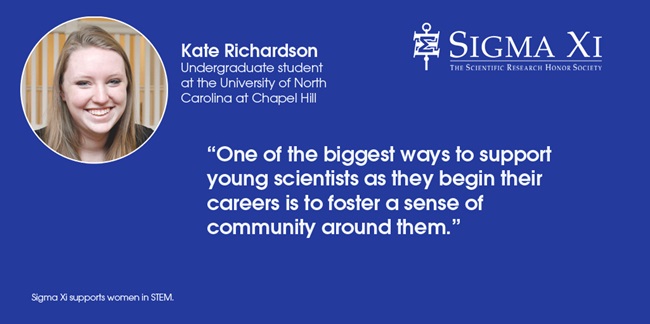
Current position
Top presenter in the Math and Computer Science category of the Undergraduate Division at Sigma Xi’s 2018 Student Research Conference; undergraduate student at the University of North Carolina (UNC) at Chapel Hill.
What challenges do you see for women working in, or studying, science, technology, engineering, or math?
Women face harassment and disregard from their superiors and peers that stops them from pursuing STEM. Additionally, not being able to have mentors that look like you is a deterrent in and of itself for young scientists. The underrepresentation of women in STEM fields is a harmful cycle: the lack of experienced professional women in STEM hurts young scientists of both sexes early in their careers, which contributes to the lack of female graduates. In 2017, only 18 percent of physics PhDs were awarded to women, according to the American Physical Society. In my experience, I have been underestimated in the classroom by both my peers and educators. This has inspired me to work to prove myself to anyone who doubts me. I have had multiple people tell me that I will not be able to complete my double major, which has strengthened my resolve to persevere when I face challenges.
What do you think could be done to help overcome those challenges?
I think that one of the biggest ways to support young scientists as they begin their careers is to foster a sense of community around them. For example, I am part of a scholarship program at UNC for underrepresented minorities in STEM, the Chancellor’s Science Scholars (CSS). CSS and the Women in Physics club have provided me support and advice through peer and staff mentors and friends with similar realities. I am constantly reminded of and try to live by the CSS motto: “If excellence is possible, then good is not enough.” Groups like this provide students with mentors and peers that share their experiences and want to support them. I think that there should be a push to start groups like this even earlier than college because I met one of my own most influential mentors in high school.
Sonya Smith
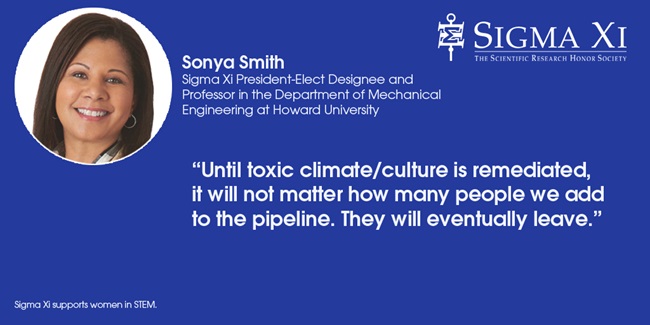
Current position
Professor in the Department of Mechanical Engineering at Howard University; Sigma Xi president-elect designee
What challenges do you see for women in science, technology, engineering, or math?
The main challenges for women working in STEM fields are the toxic climate and culture in which they often find themselves. There is much research on strategies to help women cope with, and navigate, hostile work climates: the so-called fix-the-women approaches. However, these types of approaches are not enough. Hostile climates and toxic cultures are much harder to address because it requires constant vigilance and a willingness to act on the part of administrators. Unfortunately, there is often retaliation against those who report problems rather than assistance. Until toxic climate/culture is remediated, it will not matter how many people we add to the pipeline. They will eventually leave.
What do you think could be done to help overcome those challenges?
This is very tough question because climate and culture results in part due to toxic behavior that has been normalized over time. However, in many cases, enforcing existing policies is a good start to remediating toxic climates and cultures. Paraphrasing from Martin Luther King, Jr.: It may be true that the policy enforcement cannot change the heart, but it can restrain the heartless.
More from past years of the Women in STEM project.